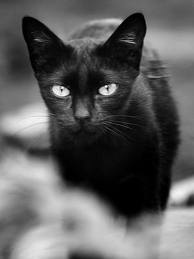Most of us are familiar with some cat mythology, and many cat tales are found all around the world from ancient times to the present day.
Cats always fascinated us, they are a symbol of grace and poise. Many of the myths and legends surrounding cats have a kernel of truth at their foundation. From the Egyptians came the legend that a cat has nine lives.
The Egyptians worshiped the cat and gifted it with nine lives, most likely for it's nimbleness and ability to land on its feet without being harmed..
There are many cat stories and tales, here we will bring you the best and most interesting ones.
Egyptian Cat
In Ancient Egypt cats were known as Mau. About 4000 to 5000 years ago cats were domesticated and accepted members of the households of Egypt. Many of the breeds we now know have evolved from these ancient cats.
The Egyptians were the first to keep and use cats to hunt fish and birds as well as to destroy the rodents that infested the grain stocks along the Nile.
Cats were considered so valuable that the Ancient Egyptians protected it by law (which they imposed the death penalty for killing cats - deliberately or not), they were revered as hunters and worshiped as gods.
Cat Mythology Fact #1: While there were many other feline goddesses worshiped by the Ancient Egyptians, Bast, also known as Basted, was the only one represented as a domestic cat. Cats were believed to be a manifestation of the goddess Bast.
Bast had many roles, including the goddess of protection, fertility, the moon, and also the protector of all cats.
Cat Mythology Fact #2: This sacred animal was so important to the Egyptian society and religion, that after the cat's death, its body was mummified and buried in a special cemetery.
Also, the Egyptians had strict laws prohibiting the export of cats. However, because cats were valued in other parts of the world for their rat-catching prowess, Phoenician traders often smuggled them out and sold them to the Mediterranean countries. Domestic cats were also found in India, China, and Japan where they were prized as pets as well as rodent catchers.
Other cultures had different views of cats. Some embraced them, others detested them. Over the subsequent centuries, the domesticated cat proliferated throughout Europe, the Middle East, and China. Though no longer worshiped as deities, cats were still honored and appreciated for their mousing abilities no matter where they turned up.
Cat Mythology Fact #3: By the 11th Century, about the time the Crusades began, cats were in huge demand since the rats were beginning to overrun the cities. Domesticated cats could now be found as far as Scotland.
Black Cats - Cat Mythology
During the Middle Ages, the Christians, however, hated cats and attempted to kill them off. They associated cats with witchcraft and Satan, much like the feared black cat of Halloween, often seen riding with a witch on her broomstick.
They were trying to establish Christianity as the only religion, and felt compelled to destroy all remnants of other cultures. The Church began what turned out to be a 1000 year killing spree of cats.
When the cat population was depleted, diseased rats took over, and spread the plague. Since many people were sick and dying, the killing of cats stopped, and they were able to hunt the mice causing the plague.
Cat Mythology Fact #4: Shortly after the cats helped obliterate the plague, the Catholic Church placed blame on the cats, and once again persecuted them.
The Holy Man and Cat Mythology
In the Islamic community, cats were respected and protected at least in part because cats were loved by the Prophet Mohammed.



According to folklore, Mohammed's cat once fell asleep on the sleeve of his robe, and rather than awake the cat, the Prophet cut off the sleeve of his robe.
It is also believed that the "M" marking on the forehead of the tabby cat was created by the Prophet Mohammed when he rested his hand on the brown of his favorite cat.
Rotaractly yours
International Understanding Committee



No comments:
Post a Comment